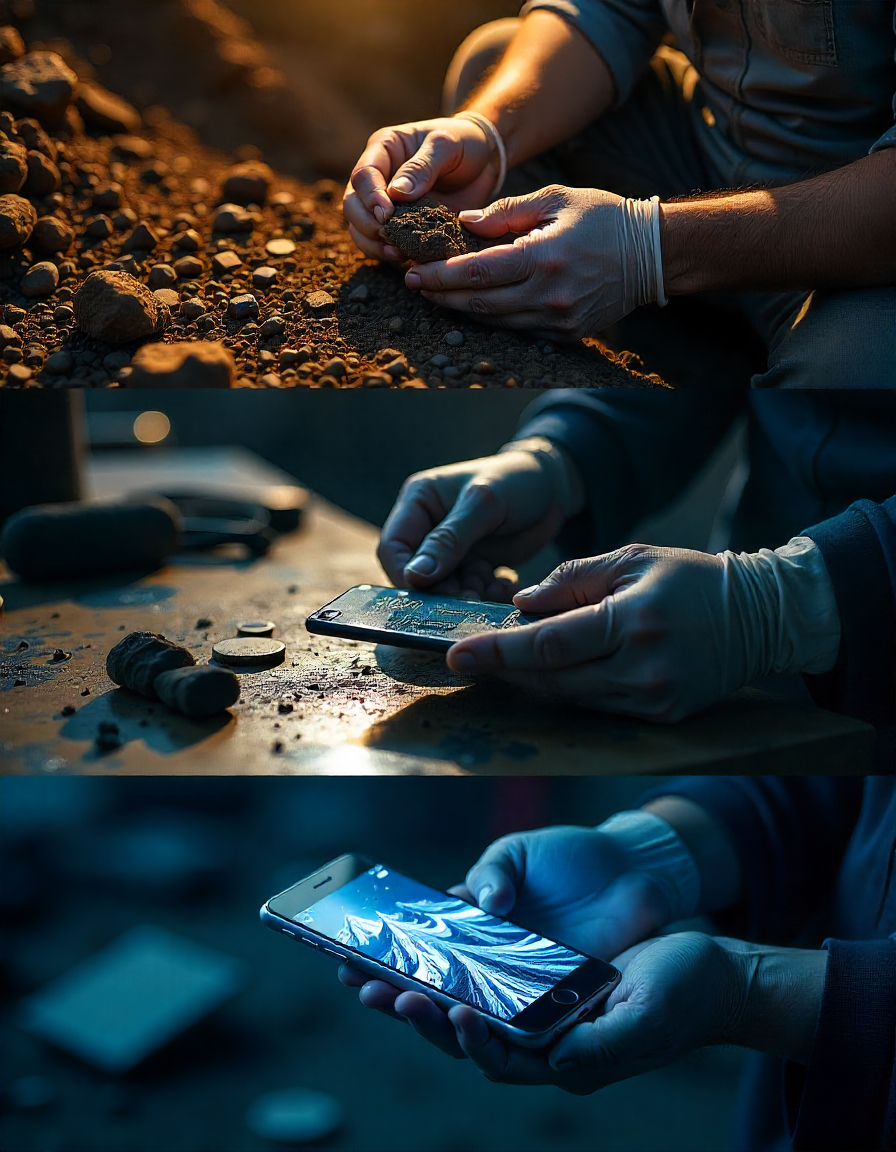
In the sweltering heat of the Democratic Republic of Congo, a 12-year-old boy named Jean-Pierre descends into a narrow tunnel, armed only with a headlamp and a shovel. His hands, calloused beyond his years, dig for cobalt—a bluish-gray metal essential for the lithium-ion batteries powering smartphones, laptops, and electric vehicles. Halfway across the world, a teenager in California unboxes her latest smartphone, marveling at its sleek design without a thought to the human and environmental toll embedded in its creation. This disconnect defines our relationship with modern gadgets: we celebrate their innovation while ignoring the complex, often exploitative systems that bring them into our hands.
The Blood Minerals: Digging for Digital Gold
Every smartphone contains approximately 62 different metals and minerals, many of which carry沉重 human and environmental costs. Cobalt, crucial for battery stability, exemplifies this dilemma. The DRC supplies over 70% of the world’s cobalt, with an estimated 20% mined by hand, often by children like Jean-Pierre. These artisanal miners work in hazardous conditions—tunnel collapses, toxic dust exposure, and constant physical exploitation—earning less than $2 per day while multinational corporations profit downstream.
The cobalt supply chain deliberately obscures these realities. Mineral traders purchase from small-scale cooperatives, mix artisanal and industrial cobalt, and sell to refiners in China who process it for battery manufacturers. By the time cobalt reaches smartphone factories, its origins are untraceable. Tech companies claim ethical sourcing policies, but audits rarely penetrate the informal mining sector where worst abuses occur.
Cobalt isn’t alone in this ethical quagmire. Tin, tungsten, tantalum (the “3TG”) and gold—used in circuitry, screens, and solder—finance armed groups in conflict zones. The Dodd-Frank Act required U.S. companies to audit supply chains for these “conflict minerals,” but enforcement remains weak. Meanwhile, alternatives like recycled materials account for less than 1% of tech manufacturing inputs.
The Water Thieves: Manufacturing’s Invisible Thirst
Beyond mineral extraction, gadget manufacturing consumes staggering natural resources. Producing one smartphone requires approximately 12,000 liters of water—enough to fill 30 bathtubs. Semiconductor fabrication plants, concentrated in water-scarce regions like Taiwan and Arizona, compete with communities and agriculture for dwindling supplies.
Taiwan’s TSMC, the world’s largest contract chipmaker, uses 156,000 tons of water daily—equivalent to 60 Olympic swimming pools. During Taiwan’s 2021 drought, the company trucked in water at great expense while local farmers faced rationing. Similar tensions play out in Arizona, where Intel’s expansion threatens groundwater reserves vital for desert communities.
Chemical contamination compounds water exploitation. Manufacturing facilities discharge heavy metals, solvents, and acids into waterways. In China’s Pearl River Delta—dubbed the “electronics workshop of the world”—studies found industrial pollutants at 100 times safe levels in water supplies near manufacturing hubs. These toxins bioaccumulate, entering food chains and causing long-term health problems for nearby residents.
The Energy Paradox: Powering Our Power-Hungry Devices
The energy footprint of gadgets extends far beyond their usage phase. Manufacturing accounts for 70-80% of a smartphone’s lifetime carbon emissions, with semiconductor fabrication being particularly energy-intensive. A single fab can consume as much electricity as a small city, often powered by fossil fuels despite corporate renewable energy pledges.
Data centers supporting cloud services and streaming add another layer of energy consumption. These facilities run 24/7, requiring constant cooling to prevent overheating. The global data center footprint now exceeds that of the entire aviation industry. While companies highlight efficiency improvements, absolute energy use continues rising with our digital appetites.
The usage phase presents its own paradox. We’ve made devices more energy-efficient, but we’re using more of them more often. The average household now has 25 connected devices, each requiring charging, updating, and eventually replacing. This multiplication effect negates efficiency gains, creating a rebound phenomenon where technological “improvements” increase overall resource consumption.
The Designed Obsolescence Machine: Engineering Waste
Perhaps most troubling is how gadget manufacturers deliberately limit product lifespans through planned obsolescence. This manifests in multiple forms: non-replaceable batteries glued into devices, software updates that slow older hardware, and repair restrictions that make fixing economically unviable.
Apple’s infamous “error 53” bricked iPhones repaired by third parties, while printer companies like HP disable cartridges when refilled. These practices force consumers into upgrade cycles, generating massive waste. The average smartphone is replaced every 2.7 years despite remaining functional for much longer.
The Right to Repair movement fights back, advocating legislation requiring manufacturers to provide parts, manuals, and diagnostic tools. States like Minnesota and New York have passed repair laws, but federal action remains stalled. Meanwhile, companies lobby aggressively against such measures, claiming safety and intellectual property concerns that rarely hold up to scrutiny.
The E-Waste Tsunami: Digital Detritus
The consequences of constant replacement manifest in staggering e-waste volumes. The world generated 53.6 million metric tons of e-waste in 2019—equivalent to 350 cruise ships in weight. Only 17.4% was formally recycled, with the rest dumped in landfills, incinerated, or processed in dangerous informal operations.
Guiyu, China, once epitomized e-waste dumping, where workers—including children—burned circuit boards to extract metals, inhaling toxic fumes. While China has since cracked down, the trade shifted to Southeast Asia and Africa. Agbogbloshie in Ghana became a digital graveyard where salvagers risk heavy metal poisoning for minimal returns.
This waste contains valuable materials—gold, silver, copper—worth an estimated $57 billion annually. Yet recycling rates remain abysmal due to design complexity and poor collection infrastructure. A typical smartphone contains gold concentrations 25-30 times higher than ore mined from the ground, yet we discard these urban mines with alarming casualness.
The Health Toll: Bodies Bearing the Burden
Throughout the gadget lifecycle, human health pays the price. Miners inhale mineral dust, factory workers handle toxic chemicals, and recyclers breathe fumes from burning plastics. These exposures cause respiratory diseases, cancers, neurological damage, and developmental disorders.
In semiconductor plants, workers face increased risks of miscarriages and birth defects from glycol ethers and other solvents. Studies show higher cancer rates among electronics assembly workers exposed to lead, cadmium, and beryllium. These impacts disproportionately affect women and marginalized communities with limited legal protections.
The psychological toll receives less attention but proves equally damaging. Factory workers report burnout from repetitive tasks and intense production quotas. Consumers experience anxiety from constant upgrade pressure and digital overload. Even our attention spans suffer as devices train us for constant distraction rather than deep focus.
The Circular Alternative: Reimagining Our Relationship with Technology
Solutions exist but require systemic transformation. The circular economy model offers a blueprint: designing products for longevity, repairability, and eventual recycling. Framework laptops demonstrate this approach with modular components users can easily replace. Fairphone prioritizes ethical materials and repairability in its smartphones.
Extended producer responsibility laws would make manufacturers financially responsible for end-of-life disposal, incentivizing better design. Japan’s Home Appliance Recycling Act achieves 80% recycling rates for electronics by requiring producers to manage collection and processing.
Consumer behavior changes matter too. Repair cafes teach basic electronics maintenance. Device refurbishment extends product lifespans. Conscious consumption asks whether we truly need the latest model. These individual actions, multiplied across millions, shift market signals toward sustainability.
Toward Technological Humility
The gadget lifecycle reveals uncomfortable truths about our technological civilization. We’ve created marvels of engineering that connect and empower us, yet we’ve externalized their true costs onto vulnerable people and ecosystems. This disconnect between innovation and ethics represents a failure of imagination as much as policy.
Moving forward requires technological humility—acknowledging that progress without responsibility is regression. This means:
- Transparent supply chains that trace materials from mine to consumer
- Design for longevity that prioritizes durability over disposability
- True cost accounting that includes environmental and social impacts in pricing
- Global justice ensuring technological benefits don’t come at others’ expense
The path isn’t simple, but the alternative—continuing down our current trajectory—guarantees increasing exploitation and ecological damage. Our gadgets connect us to the world; it’s time we connected with the full story of their creation.
In that Congolese mine, Jean-Pierre emerges from the tunnel, his small sack of cobalt worth a fraction of the smartphone it will eventually power. His reality collides with our digital convenience in ways we can no longer ignore. The choice remains ours: maintain willful ignorance or demand technology that honors human dignity and planetary boundaries. The gadgets in our pockets carry the weight of that decision.

 12 August 2025
12 August 2025 Share
Share